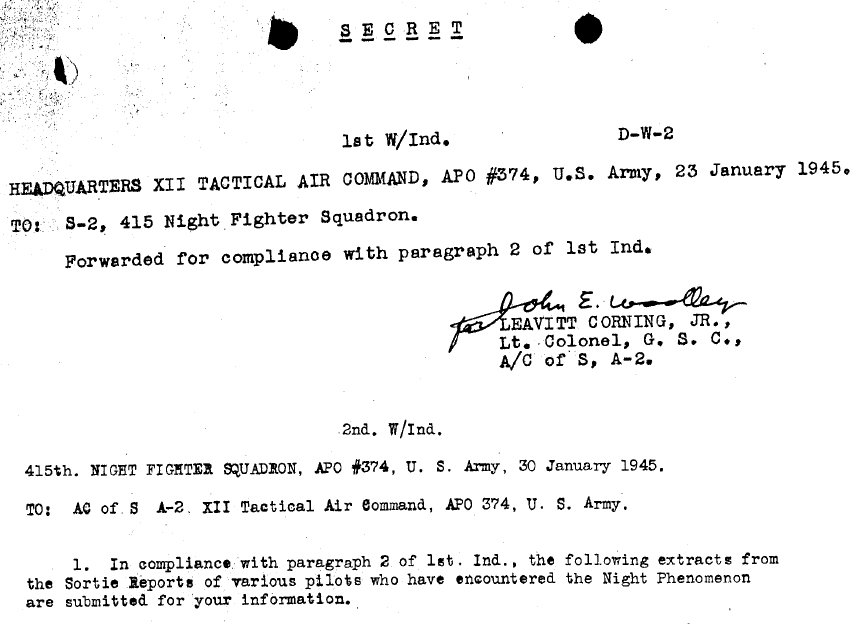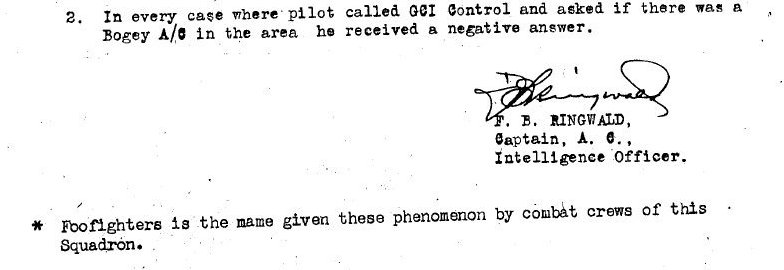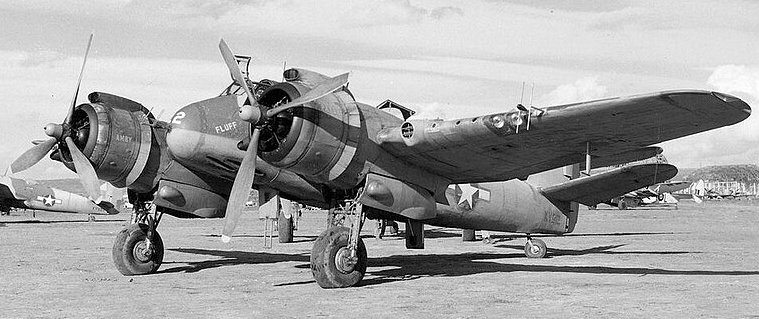ACUFO-1944-12-26-WORMS-1
Fred B. Ringwald was the Intelligence officer of the 415th Night Fighter Squadron. He had been himself a witness of the mysterious “foo fighters” when the Squadron operated intrusion missions over the Rhine Valley in 1944. He interviewed other witnesses, and told of a number of such reports in a summary Intelligence Report to A-2, XII Tactical Air Command, U.S. Army Air Forces, on January 23, 1945.
In this document, he indicated that on the night of December 26 to 27, 1944, there was a sighting of a light at the same altitude of a night fighter plane in vicinity of Worms, Germany. The light was seen coming to within 100 feet; the pilot peeled off and took evasive action but the light continued to follow for 5 minutes. In the end, the light then pulled up rapidly and went out of sight.
| Date: | December 26 or 27, 1944 |
|---|---|
| Time: | Probable night. |
| Duration: | 5 minutes. |
| First known report date: | January 23, 1945 |
| Reporting delay: | Hours, 1 month. |
| Country: | Germany |
|---|---|
| State/Department: | Rheinland-Palatinate |
| City or place: | Worms |
| Number of alleged witnesses: | 1 or 2 |
|---|---|
| Number of known witnesses: | 1 or 2 |
| Number of named witnesses: | 0 |
| Reporting channel: | Report of the units' intelligence officer. |
|---|---|
| Visibility conditions: | Probable night. |
| UFO observed: | Yes. |
| UFO arrival observed: | ? |
| UFO departure observed: | Yes. |
| UFO action: | Approaches, follows maneuvers. |
| Witnesses action: | Evasive action. |
| Photographs: | No. |
| Sketch(s) by witness(es): | No. |
| Sketch(es) approved by witness(es): | No. |
| Witness(es) feelings: | Puzzled. |
| Witnesses interpretation: | ? |
| Sensors: |
[X] Visual: 1 or 2.
[ ] Airborne radar: Not reported. [ ] Directional ground radar: Not reported. [ ] Height finder ground radar: [ ] Photo: [ ] Film/video: [ ] EM Effects: [ ] Failures: [ ] Damages: |
|---|---|
| Hynek: | NL |
| Armed / unarmed: | Armed, four 20 mm cannons and six 7,62 mm machines guns. |
| Reliability 1-3: | 3 |
| Strangeness 1-3: | 3 |
| ACUFO: | Possible extraterrestrial craft. |
[Ref. rwd1:] FRED B. RINGWALD, INTELLIGENCE, U.S. ARMY AIR FORCES:
Note: the document that follows was retrieved by Jan Aldrich's historical ufology effort Project 1947, at www.project1947.com/fig/1945a.htm
Only the header, the footer and the part related to the case documented in this file are shown.
Only other cases are removed, as they are shown in their own case file in this catalog.

|
S E C R E T
1st W/Ind
D-W-2
HEADQUARTERS XII TACTICAL AIR COMMAND, APO #374, U.S. Army, 23 January 1945.
TO: S-2, 415 Night Fighter Squadron.
Forwarded for compliance with paragraph 2 of 1st Ind.
[Signature]
LEAVITT CORNING, JR,.
Lt. Colonel, G.S.C,.
A/C of S, A-2.
2nd W/Ind
415th. NIGHT FIGHTER SQUADRON, APO #374, U. S. Army, 30 January 1945.
TO: AC of S A-2. XII Tactical Air Command, APO 374, U. S. Army.
1. In compliance with paragraph 2 of Ist. Ind., the following extracts from the Sortie reports of various pilots who have encountered the Night Phenomenon are submitted for your information.
[... other cases...]

|
[... other cases...]
Night of 26-27 December 1944 - “Observed light at same altitude while in vicinity of Worms. Observer saw light come within 100. Peeled off and took evasive action but light continued to follow for 5 minutes. Light then pulled up rapidly and went out of sight.”
[... other cases...]

|
2. In every case where pilot called GCI Control and asked if there was a Bogey A/C in the area he received a negative answer.
[Signature.]
F. B. Ringwald
Captain, A.C.
Intelligence Officer
* Foofighters is the name given these phenomenon by combat crews of this Squadron.
S E C R E T
[Ref. bgd1:] BARRY GREENWOOD:
Barry Greenwood, in an article about the “Foo-Fighters” documents in the U.S. military archive, said:
A summary of incidents [reported by airmen of the U.S. Army Air Forces 415th Night Fighter Squadron] was prepared by Captain F. B. Ringwald, Intelligence Officer with Headquarters 12 of the Tactical Air Command to advise S-2 of the “Night Phenomenon” encountered by the pilots and dated January 30, 1945.
Barry Greenwood then cited 13 cases from Ringwald's report, including this one:
“Night of 26-27 December 1944 - Observed light at same altitude while in vicinity of Worms. Observer saw light come within 100 ft. Peeled off and took evasive action but light continued to followed for 5 minutes. Light then pulled up rapidly and went out of sight.”
Barry Greenwood then indicated that a hand-written insert by Jo Chamberlin into Ringwald's report noted:
"Flying at 1000 ft. They were looking for trains and motor transports. Lights at first were some distance off - a single yellow glow came closer and light forced plane in a dive. One night Photo Recon outfit, the 155th with 9th Air Force, saw orange blob. Cpt. Edward Sentcher, operations officer, told Schlueter about orange blobs.")
Greenwood published a scan of this handwritten note.
Barry Greenwood commented about these reports:
It is noteworthy to point out that these pilots made a distinction between the usual flak bursts sent up by anti-aircraft fire and what they were seeing in these incidents. One might expect that due to technical advances during the war, eventually one side may develop a new sort of anti-aircraft weapon that could behave in an intelligent manner in pursuit of enemy planes. The problem with this here is that there are no known reports of “Foo Fighters” bringing down aircraft of either side. The objects that seemed to be “under perfect control at all times” didn't seem to do damage but merely accompany planes on their respective missions without interference.
To end the summary, Ringwald said that in each case where the pilot called GCI control to ask if “Bogey A/C” were in the area, he received a negative answer. It was also noted, perhaps more of interest to modern audiences, that these objects were called “Foofighters.” One word only, which should we call it? Chamberlin added his own written footnote for another sighting on February 28: "Returning, 45 miles East of Base (Loral Ochey) sighted foo fighters to rear starboard. Orange red in color. Turned to have a look and it disappeared. Near Luneville, SECRET north of Strasbourg. Lt. Buscio & Krasner RO.”
[Ref. dwn2:] DOMINIQUE WEINSTEIN:

|
At night, the crew of a Beaufighter from the USAAF 415th Night Fighter Squadron observed one light at the same altitude. Then they saw lights coming within 100 feet. The pilot peeled off and took an evasive action but the light continued to follow the aircraft for five minutes. The light then “pulled up rapidly and went out of sight”.
Sources: USAAF, Report from Captain F.B. Ringwald, Intelligence Officer, 415th Night Fighter Squadron, To AIC ofS,A-2 XII Tactical Air Command, January 30, 1945, NARA/ Strange Company, Keith Chester, 2007
[Ref. sua1:] WEBSITE "SATUDAY NIGHT UFORIA":
...come December, 1944 members of the 415th would be making multiple reports, as recorded in a January 30, 1945 report to Tactical Air Command by intelligence officer Fred Ringwald...
Night of 26-27 December 1944 - “Observed light at same altitude while in vicinity of Worms. Observer saw light come within 100 ft. Peeled off and took evasive action but light but light continued to follow for 5 minutes. Light then pulled up rapidly and went out of sight.”
The Bristol Type 156 “Beaufighter“, nicknamed “Beau”, was a British multi-role aircraft developed during WWI. It was originally conceived as a heavy fighter variant of the Bristol Beaufort torpedo bomber; it proved to be an effective night fighter, which came into service with the Royal Air Force (RAF) during the Battle of Britain.
Originally, armament consisted of four 20mm cannons and six 0.303-in machine-guns but many variants were built; for example, versions had the ability to additionally carry eight rocket projectiles, some had a Vickers 'K' gun, Beaufighter TF.Mk X was used for anti-shipping operations.
The Beaufighter Mk VIF was fitted with the Mark VIII radar.
Below: Beaufighter Mk VIF of the 415th Night Fighter Squadron.

|
The Beaufighters served with the U.S. Army Air Forces until the end of the war, but most were replaced by the P-61 “Black Widow” beginning on March 20, 1945.

|
Fred Ringwald's report was specifically devoted to phenomena considered to be so-called “Foo-fighters”, it was not a report on military operations in general.
We will note an approach of the light towards the plane at a distance said to be less than 33 meters; which makes it unlikely that it was an ordinary light on an enemy aircraft.
This light follows the evasive maneuvers of the plane, it is there for 5 minutes, and it has no hostile action against the plane.
Possible extraterrestrial craft.
* = Source is available to me.
? = Source I am told about but could not get so far. Help needed.
| Main author: | Patrick Gross |
|---|---|
| Contributors: | None |
| Reviewers: | None |
| Editor: | Patrick Gross |
| Version: | Create/changed by: | Date: | Description: |
|---|---|---|---|
| 0.1 | Patrick Gross | January 18, 2024 | Creation, [rwd1], [dwn2], [sua1]. |
| 1.0 | Patrick Gross | January 18, 2024 | First published. |
| 1.1 | Patrick Gross | June 9, 2024 | Addition [bgd1]. |